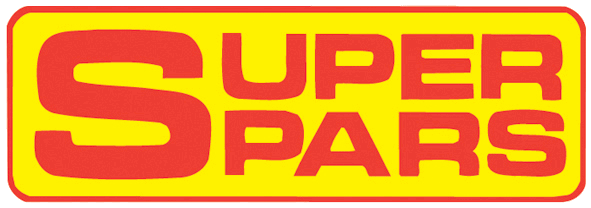Carbon Spars

The Black Art Of Carbon Spar Production
The use of advanced composites has rapidly developed over the past few years and especially in the production of Dinghy Racing spars during recent seasons. Many Classes have either allowed a change to Carbon Spars or are reviewing the possibility of change. A mast is used to hang the sails on and to control the leading (luff) edge of the sail for shape control. Its disadvantages are weight, plus drag from windage. Anything that can reduce weight and improve sail control will improve the performance of a racing dinghy or yacht.
Carbon Spars: what are the advantages?
A well built SUPERSPARS CARBON mast will be lighter, stronger and stiffer than its counterpart in Aluminium. Unlike Aluminium, where the material is well controlled and almost uniform in quality, a Carbon mast can be constructed from a wide range of raw materials and production systems that affect the characteristics of the finished product. All these factors affect the strength, stiffness and weight of the tube. When comparing a SUPERSPAR designed mast with other manufacturers there are significant differences and in fact the only common factor is the colour - BLACK!
Weight:Carbon can generally offer up to 50% saving in weight! With less weight aloft, the dinghy will require less weight from the crew to balance the pressure in the sail plan and will convert more energy into forward motion. It will also lift onto the plane earlier, a significant factor in high performance craft.
A further advantage comes from sailing in waves. There is significantly less momentum from a lighter rig and this reduces the tendency for the ends of the boat to "dig in" as it crosses waves.
Stiffness:With the right stiffness component, it will also prove to support the sail more efficiently. Sail shape is more easily controlled adding to further improvement in power. Carbon will also bend significantly more than an Alloy spar before breaking.
Strength:
The SUPERSPARS Carbon section will be stronger (when optimised correctly) than its Aluminium counterpart and is more likely to survive at times of crisis, such as a bad capsize or collision.
How is the design criteria developed?
Much of the design concept for a new mast comes from design experience producing aluminium sections, and developing the right combination of strength, spreader control and rig specification. Alloy is a totally homogeneous material with very predictable and known engineering qualities. A further characteristic is that its stiffness does not vary, and slight variations in the alloy will have little effect on the stiffness of the extruded tube.
However, Alloy sections cannot be changed along their length, so sleeving or stiffening may have to be added in certain areas to support sailing loads. There is also a production limit for the best alloys, which cannot be extruded below a certain wall thickness. Alloy does not lend itself to the production of small volumes, so a "general, all round" specification is often selected by manufacturers rather than one optimised for the individual.
The Carbon specification has to offer a significant or measurable
improvement in performance. The specification will be optimised for
weight saving, but with all the components of strength required to
support the rig. This is where Carbon spars score over aluminium extrusion.
Areas of increased strength, such as around the gooseneck can be incorporated into the production specification to accommodate high stress areas of the tube. In Aluminium spars this would require an internal sleeve of similar section, with a proportional increase in weight. Areas of high stress requiring extra stiffness can be easily catered for in the production process.
"Horizontal" PerformanceThis is a significant factor, especially for high aspect rigs like Thames A Raters, or modern Sports Boats. Everyone wants ease of preparation nowadays and hoisting the spar into place can make the difference between the dinghy or yacht design being accepted or not. Carbon can not only reduce weight aloft by up to 50% and lower the centre of Gravity (C of G), but also make that operation safer.
More importantly, on the race circuit, a capsize is about as expensive as it gets, and Carbon significantly reduces that possibility for just the same reasons. Some Sportsboat designs ONLY pass the righting tests with a Carbon spar.
Upper Mast DesignThe development of the upper sections are essential to the design programme. Both the right section and strength components have to be introduced to create SUPERSPARS unique Dynamic Gust Response (DGR). Identifying this DGR factor in Aluminium spars has led to outstanding and proven success in many International classes. The right amount of sideways 'springiness' in the upper mast (allowing the leach of the mainsail to reduce power through gusts) adds up to less adjustment to the sail trim from the helmsman, so more speed.
This same DGR factor is designed into all SUPERSPARS Carbon masts but with with even more performance gain. Carbon stiffness in the upper sections can be even more accurately controlled.
Finally, each dinghy design has to take into consideration the overall hull/crew weight, the sail plan and the current sail designs (flat or full) to achieve the optimum Carbon section.
Cloth Lay Up: Stiffness and Strength?
Carbon fibre is a very strong material in tension but pretty useless in compression - unless the fibres can be held in column. This is achieved by using the strongest bonding material - Epoxy resin. Careful testing and analysis over many years has allowed us to achieve an optimum strength component in three dimensions by incorporating a design which is interwoven with a three diagonal lay up. By modifying the direction of these layers, the strength can be varied in different directions.
The largest percentage of fibres run longitudinally along the spar to support the huge compression loads. Other fibres are laid at 90 degrees to these to prevent crushing and to strengthen holes required for attaching fittings. More are laid at 45 degrees to prevent torsional (twisting) loads created by shrouds, goosenecks etc. and especially from spreaders.
The Product Process - Resin Pressure and Heat
There are several methods of moulding the tube. Resin in its cured state is brittle and is of little use other than to lock Carbon fibres in place. Whereas more alloy would increase strength of an Alloy spar, more resin both weakens and increases the weight of a Carbon spar.
SUPERSPARS have adopted a production system that utilises Pre-impregnatedCarbon material, to ensure the correct amount of resin and its even distribution, unlike the 'wet layup' principal which is used by other manufacturers.
Heat and pressure are required to ensure that all gaps and voids are filled and that the curing process is accurately, and repeatably controlled. Unlike SUPERSPARS, very few Spars currently produced for the Dinghy market have all the above elements. But they all share one common feature - the colour BLACK.
The Superspar SystemMale moulding - machine wound Pre-preg cloth
Pre preg cloth is wound onto a mandrel for accurate repeatability. This system allows for fine mesh carbon cloth to be laid accurately along the longitudinal axis. As sailmakers know, just a degree or so off the axis will dramatically change the characteristics. Cloth can also be laid accurately at defined degrees of angle, and numerous layers can be applied for increased strength in specific areas.
Male moulding - machine wound tape fibresThis is an alternative process but fibres are utilised rather than cloth. Again these are machine wound for repeatable quality, but the nearest achieveable angle to the axis is only 5 degrees, not zero degrees, and for this reason we do not employ this system.
Shrink wrapping tape is applied and when heated it shrinks, applying pressure on the resin to remove voids and air bubbles. This is fine on SUPERSPAR circular tubes, but when used by other manufacturers on oval or shaped tube section mandrils, the shrink wrap tape squeezes resin from the important curved edges, and displaces it onto the flatter surfaces. The effect is dramatic for the end product - more resin in the wrong place. A classic example of this was in the development of the BOSS Carbon mast. Initial masts from one producer using a shaped section produced a mast 50% heavier than the final selection of circular section produced by SUPERSPARS.
Female MouldingThis system is associated with hand layup. Whilst the fibres can be laid accurately, it suffers from lack of uniform quality and the tube has to be built in two sections and additional weight associated with the jointing process. It is NOT used by SUPERSPARS
PulltrusionThis process employs unidirectional fibres and 'pulls' pre-preg fibres through a mould where the fibres are compacted and heated. Ideal for volume production, this system produces a tube that is strong in compression but with no cross directional layers, the tube is often easily crushed. It is NOT used by SUPERSPARS.
Which Classes have selected Carbon?
There have been a large number of both UK and European Classes taking the important step into Carbon Spars. It is a difficult decision because it will likely create contention between those who resist change and those who want to improve performance.
Changing to Carbon will not reduce costs, but it certainly may give a Class a new lease of life, simply by improving performance and reliability.
Recent Classes to select Carbon spars include:
RS 300, BOSS, CHERUB, RS 600, FLYING DUTCHMAN, H JOLIE, RS 700, INT. FOURTEEN, MERLIN ROCKET, EUROPE, INT. CANOE, MICRO 18, MUSTO PERFORMANCE SKIFF, NAT. TWELVE, NORFOLK PUNT, PHANTOM, RACER CRUISERS, THAMES 'A' RATER, VIS.
If further proof is needed then just a quick look at the big racing yacht scene, or aerospace industry is pretty convincing. Virtually all new performance yachts are now built with Carbon spars, where the weight saving and increased stiffness is significant. Virtually all modern light aircraft have moved from traditional aluminium construction to complex designs in Carbon - for all the same reasons already mentioned.
Long Term Advantages for the Individual and the Class?
A SUPERSPARS Carbon mast is just as maintenance free as its aluminium counterpart. There are masts in existence that date back many years that show no sign of performance loss, whereas it is true that a hard working aluminium spar will begin to 'soften' after a number of seasons. This softening can often be overcome by increased rig tension.
In extreme conditions, or after a capsize the aluminium mast will permanently bend or even break, requiring immediate retirement from a race. Occasionally, the bend can be reversed. With the Carbon spar this does not happen. It can bend more, but If it is taken beyond the designed strength or bend characteristic, then it will break - usually with a loud bang!
For a Class, the selection of a SUPERSPARS Carbon spars will generally improve performance, but there is another twist. If the Class is One Design then the spar MUST be fully developed before its introduction, otherwise there could be several quality or design levels. SUPERSPARS pride themselves on the very considerable design work they have achieved to introduce new Class sections on popular UK and European Dinghies during the past few years. If the design is right, there is no 'down' side.
Repeatable quality & Performance?
Finally, any producer has to offer consistent, repeatable quality. Many manufacturers say they can, but unlike aluminium section that nowadays is mostly consistent, each Carbon mast is individually made and so quality control of the construction specification is essential, both for the individual sailor and for the Class. Although a greater level of skill is required to produce Carbon spars and it is more expensive, the SUPERSPARS Carbon option does offer a significant increase in performance, reliability and safety!
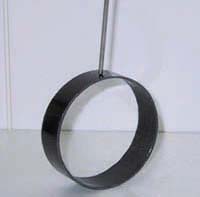 |
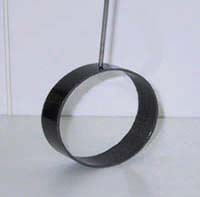 |
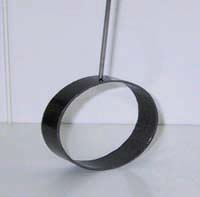 |
|
They
may be black but different manufacturers sections are very different!
In test conditions (see pictures above) the crushing effect on sections (designed for the same boat) from three different manufacturers were dramatically different. "BREAK POINT" This picture shows a carbon tube at the moment of break, during a test sail. Note: The carbon mast in the picture is NOT a Super Spars mast! |
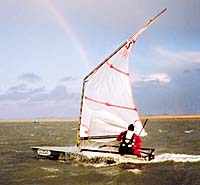 This is NOT a Super Spars mast! |
